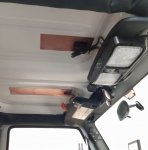chiwititsara
Member
- Joined
- Dec 2, 2015
- Messages
- 23
- Reaction score
- 9
I see a thread active today discussing multiple antennas and multiple radios. My situation is different in that one of my devices is receive-only.
So, this is either an odd situation or an easy answer, hence why I cannot find the same scenario via search:
In my Jeep, I regularly use a (1) VHF/UHF mobile transceiver. I also use (2) a handheld scanner sitting in my cupholder, often making use of the same NMO roof-mount antenna-to-coax-to-BNC connector that is primarily intended for transceiver use. I listen far more than I speak. And I NEVER have both devices turned on at the same time (since I only have one antenna) and do not need to use them at the same time.
For example, I'll be scanning via the roof-mount antenna and hear someone calling CQ on an amateur frequency. To switch to my (1) transceiver, I unplug the BNC-terminated NMO antenna-into-cabin coax and this same coax line-antenna is then plugged in to my transceiver so I can transmit.
This is *not* convenient/safe while driving down the highway (the disconnection process isn't bad, but trying to plug into the back of the mobile transceiver while driving is).
I do not use these two devices at the same time...EVER. If I hear CQ on the scanner, I move to the (1) transceiver... The (2) scanner is turned off and disconnected from the antenna. I don't have the attention span to listen to a scanner while talking on the radio anyway, and I rarely transmit.
A. I would like to mount a second antenna (perhaps a little wider-band, a little less gain/height) for the scanner so I avoid having to swap the coax back-and-forth while driving. This is a barely street-legal Jeep and I could not care less about cutting more holes and running more wires. I have tons of NMO mounts and antennas sitting around.
Assuming I do mount a second antenna...
B. Given the fact that these devices are NEVER used at the same time, is there ANY separation concern (distance from the existing antenna) regarding placement of a second, RX-only scanner antenna?
B(i). Note 1: This plan contemplates that If I am using my transceiver (on Antenna 1), the scanner will be at a minimum switched off, although since it is a handheld unit, I could easily disconnect the BNC-terminated cable from the scanner (if switching the scanner off is insufficient to avoid overloading a turned-off scanner through it's antenna, noting also that my mobile transceiver puts out no more than 20 watts on a good day).
B(ii). Note 2: If I switch back to using my scanner, the transceiver will no longer be transmitting and, unless I forgot to switch it off, not listening either. Life will be much easier when I no longer have to connect/disconnect the transceiver antenna coax to/from this mobile radio just to have an external scanner antenna.
C. The 'Obvious' Solution: By this point, you are probably thinking that the far easier solution is a manual switch that would cut-off one of the two devices from the (single, shared) antenna when the other device is using the antenna. However, these cost upwards of $50, introduce some amount of insertion loss (admittedly, not much), and most importantly, I already have a pile of NMO mounts, antennas, and no problem cutting more holes in my beater Jeep. The 'second-antenna' approach would be a 100% free project. And, with a second NMO mount, would open up later opportunities to buy a switch and use different types of antennas for different circumstances / bands.
---
TL;DR - How much separation - if any - is needed between two vehicle-roof-mounted VHF/UHF antennas, each serving a separate device (one of which is an RX-only scanner) when the two devices (and thus the antennas) will NEVER be used at the same time.
As long as they are not nearly-touching each other, does separation even really matter in this scenario?
So, this is either an odd situation or an easy answer, hence why I cannot find the same scenario via search:
In my Jeep, I regularly use a (1) VHF/UHF mobile transceiver. I also use (2) a handheld scanner sitting in my cupholder, often making use of the same NMO roof-mount antenna-to-coax-to-BNC connector that is primarily intended for transceiver use. I listen far more than I speak. And I NEVER have both devices turned on at the same time (since I only have one antenna) and do not need to use them at the same time.
For example, I'll be scanning via the roof-mount antenna and hear someone calling CQ on an amateur frequency. To switch to my (1) transceiver, I unplug the BNC-terminated NMO antenna-into-cabin coax and this same coax line-antenna is then plugged in to my transceiver so I can transmit.
This is *not* convenient/safe while driving down the highway (the disconnection process isn't bad, but trying to plug into the back of the mobile transceiver while driving is).
I do not use these two devices at the same time...EVER. If I hear CQ on the scanner, I move to the (1) transceiver... The (2) scanner is turned off and disconnected from the antenna. I don't have the attention span to listen to a scanner while talking on the radio anyway, and I rarely transmit.
A. I would like to mount a second antenna (perhaps a little wider-band, a little less gain/height) for the scanner so I avoid having to swap the coax back-and-forth while driving. This is a barely street-legal Jeep and I could not care less about cutting more holes and running more wires. I have tons of NMO mounts and antennas sitting around.
Assuming I do mount a second antenna...
B. Given the fact that these devices are NEVER used at the same time, is there ANY separation concern (distance from the existing antenna) regarding placement of a second, RX-only scanner antenna?
B(i). Note 1: This plan contemplates that If I am using my transceiver (on Antenna 1), the scanner will be at a minimum switched off, although since it is a handheld unit, I could easily disconnect the BNC-terminated cable from the scanner (if switching the scanner off is insufficient to avoid overloading a turned-off scanner through it's antenna, noting also that my mobile transceiver puts out no more than 20 watts on a good day).
B(ii). Note 2: If I switch back to using my scanner, the transceiver will no longer be transmitting and, unless I forgot to switch it off, not listening either. Life will be much easier when I no longer have to connect/disconnect the transceiver antenna coax to/from this mobile radio just to have an external scanner antenna.
C. The 'Obvious' Solution: By this point, you are probably thinking that the far easier solution is a manual switch that would cut-off one of the two devices from the (single, shared) antenna when the other device is using the antenna. However, these cost upwards of $50, introduce some amount of insertion loss (admittedly, not much), and most importantly, I already have a pile of NMO mounts, antennas, and no problem cutting more holes in my beater Jeep. The 'second-antenna' approach would be a 100% free project. And, with a second NMO mount, would open up later opportunities to buy a switch and use different types of antennas for different circumstances / bands.
---
TL;DR - How much separation - if any - is needed between two vehicle-roof-mounted VHF/UHF antennas, each serving a separate device (one of which is an RX-only scanner) when the two devices (and thus the antennas) will NEVER be used at the same time.
As long as they are not nearly-touching each other, does separation even really matter in this scenario?





